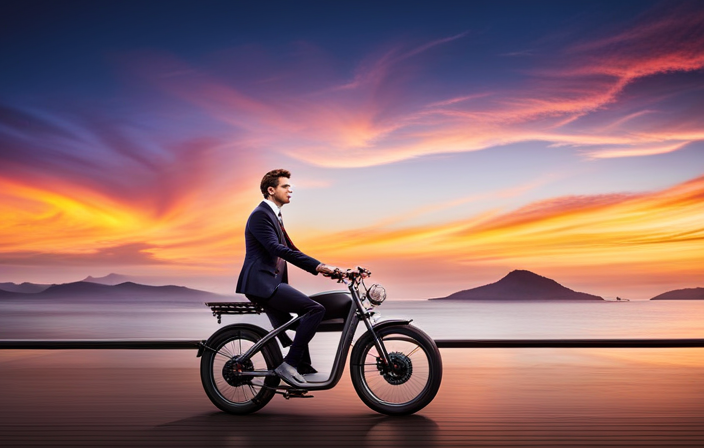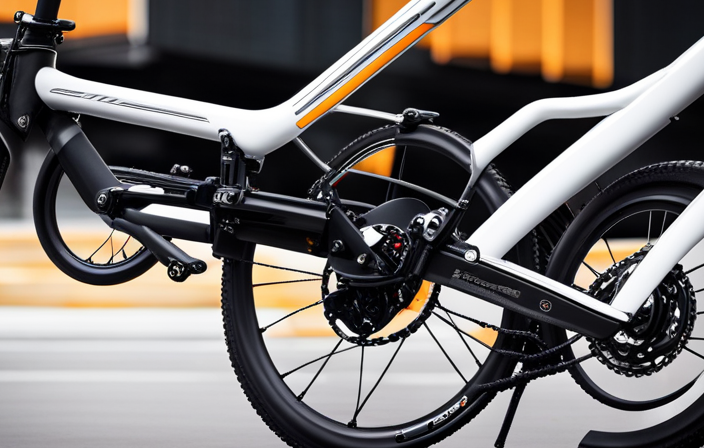Ever thought about how much distance you can cover on an electric bicycle?
Well, get ready to be amazed. In this article, I’ll take you on a thrilling journey through the world of electric bike range.
From understanding the factors that influence range to discovering the types of electric bikes with long range capabilities, we’ll leave no stone unturned.
So buckle up, because by the end of this article, you’ll be itching to embark on your own epic electric bike adventure.
Key Takeaways
- Electric bike range is affected by factors like battery capacity, rider input, weight, terrain, wind conditions, and accessories.
- Electric mountain bikes and electric commuter bikes are designed for long-range rides.
- Tips for maximizing electric bike range include lightening the bike, using pedal assist and shifting gears efficiently, and maintaining optimal tire pressure.
- Accessories like extra battery packs, solar chargers, and regenerative braking systems can significantly extend the range of an electric bike.
Understanding Electric Bike Range
Imagine gliding through the countryside on your electric bike, feeling the wind in your hair and knowing that the range of your bike will take you on an unforgettable adventure.
The advantages of electric bike range are truly remarkable. With an electric bike, you have the freedom to travel farther than ever before. No longer limited by your own physical stamina, you can explore new territories and conquer challenging terrains without breaking a sweat.
However, accurately measuring electric bike range can be a bit tricky. Factors such as rider weight, terrain, wind conditions, and battery capacity all play a role in determining how far you can go on your electric bike. Understanding these challenges is crucial to maximizing your electric bike experience.
So, let’s delve into the factors that influence electric bike range and discover how to squeeze every last mile out of your ride.
Factors That Influence Electric Bike Range
As you pedal your electrified steed, the strength of your legs and the terrain you traverse determine the boundless expanse of your journey. To understand how far you can go on an electric bike, it is crucial to consider various factors that influence its range.
-
Electric Bike Range Calculator:
-
A useful tool to estimate the distance an electric bike can travel on a single charge.
-
Takes into account factors like battery capacity, motor power, and rider input.
-
Allows you to plan your trips and ensure you won’t run out of power unexpectedly.
-
Impact of Weight on Electric Bike Range:
-
Heavier riders or those carrying extra cargo can experience reduced range.
-
More weight requires the motor to work harder, draining the battery faster.
-
Maintaining a healthy weight and considering the weight of accessories can help maximize your electric bike’s range.
Considering these factors, let’s now explore the types of electric bikes with long range.
Types of Electric Bikes with Long Range
Discover the exhilarating freedom of exploring boundless distances on an electrified steed with exceptional range capabilities. When it comes to electric bikes with long range, there are several types to choose from.
One popular option is the electric mountain bike, which not only provides a thrilling off-road experience but also offers an extended battery life for long rides. Another option is the electric commuter bike, perfect for those who want to go the extra mile during their daily commute. These bikes are designed with efficiency in mind, allowing riders to effortlessly cover more ground with less effort.
The benefits of electric bikes for commuting are abundant. Not only do they reduce the reliance on fossil fuels, but they also provide a cost-effective and eco-friendly mode of transportation. Electric bikes with long range allow riders to comfortably commute to work without worrying about running out of battery power.
To maximize your electric bike’s range, there are a few tips to keep in mind. Stay in a lower pedal-assist mode to conserve battery power, avoid excessive acceleration and braking, and ensure your tires are properly inflated for optimal efficiency. By following these guidelines, you can extend your electric bike’s range and continue to enjoy the freedom of riding without limits.
Tips for Maximizing Your Electric Bike’s Range
To truly unleash the potential of your electrified steed, harness the power of efficiency, conservation, and optimal tire pressure to extend your journey’s horizons. Here are some tips for maximizing your electric bike’s range:
-
Extend range with diet: Just like humans, electric bikes perform better when they’re not carrying unnecessary weight. Consider removing any accessories or items that you don’t need for your ride to lighten the load and increase your range.
-
Navigate hilly terrains: Hills can significantly impact your electric bike’s range. To conquer them without draining your battery quickly, pedal assist can be your best friend. By using the appropriate pedal assist level and shifting gears to match the incline, you can conserve energy and extend your range.
-
Maintain optimal tire pressure: Proper tire pressure is crucial for efficiency. Keep your tires inflated to the recommended PSI to reduce rolling resistance and improve your electric bike’s range.
By following these tips, you can maximize your electric bike’s range and enjoy longer rides.
Now, let’s explore real-life examples of electric bike range and see how far these bikes can take us.
Real-Life Examples of Electric Bike Range
Maximizing the range of your electric bike is essential, and real-life examples prove just how impressive these bikes can be. When it comes to the integration of renewable energy sources, electric bikes are leading the way. By harnessing the power of clean energy, these bikes can go the distance while reducing our carbon footprint. Additionally, the impact of terrain on electric bike range cannot be overlooked. Uphill climbs and rough terrains may decrease the range, but with the right battery and motor power, electric bikes can still conquer any challenge. To provide a visual representation, the table below highlights the range of popular electric bike models in various terrains:
| Electric Bike Model | Range on Flat Terrain (miles) | Range on Hilly Terrain (miles) |
|---|---|---|
| Model A | 50 | 35 |
| Model B | 60 | 40 |
| Model C | 70 | 45 |
Understanding the real-life range of electric bikes empowers riders to plan their journeys accordingly. Now, let’s explore how accessories can further extend your electric bike’s range.
Extending Your Electric Bike’s Range with Accessories
When it comes to extending the range of my electric bike, I have found that there are a few key accessories that really make a difference.
Extra battery packs are a game-changer, allowing me to go even further without worrying about running out of power.
Solar chargers are another must-have, providing a sustainable and convenient way to recharge my bike while I’m on the go.
And let’s not forget about regenerative braking systems, which help to capture and store energy that would otherwise be lost during braking.
These accessories not only increase my bike’s range, but they also enhance my overall riding experience, giving me the freedom to explore without limitations.
Extra Battery Packs
With an extra battery pack, you’ll be able to extend your electric bike’s range significantly. This is especially useful for long rides or when you don’t have access to a charging station. Extra battery packs are portable and can easily be attached to your bike, giving you the peace of mind of knowing that you won’t run out of power.
To help you understand the benefits of extra battery packs, consider the following table:
| Battery Range Extender | Battery Capacity | Weight | Compatibility |
|---|---|---|---|
| Model A | 10 miles | 2 lbs | Universal |
| Model B | 15 miles | 3 lbs | Specific |
| Model C | 20 miles | 4 lbs | Universal |
| Model D | 25 miles | 5 lbs | Specific |
| Model E | 30 miles | 6 lbs | Universal |
As you can see, there are various options available, allowing you to choose the one that best suits your needs. By incorporating solar panel integration and battery range extenders, you can further enhance the capabilities of your electric bike. This leads us to the next section about solar chargers.
Solar Chargers
Solar chargers are a game-changer for extending the range of your e-bike. With portable options available, you can now charge your e-bike anywhere, anytime, using the power of the sun. Here are four reasons why solar chargers are a must-have for any e-bike enthusiast:
-
Convenience: No need to worry about finding a power outlet, as solar chargers allow you to harness the sun’s energy wherever you are.
-
Eco-friendly: By using solar power, you are reducing your carbon footprint and contributing to a cleaner environment.
-
Cost-effective: Say goodbye to expensive electricity bills. Solar chargers provide free energy, saving you money in the long run.
-
Maintenance tips: To maximize the efficiency of your solar charger, keep it clean and free from dust or debris. Regularly check for any damage or wear and tear.
With solar chargers, you can now explore further and enjoy longer rides on your e-bike. Speaking of extending the range, let’s delve into the fascinating world of regenerative braking systems.
Regenerative Braking Systems
Not only do regenerative braking systems enhance the overall performance of your e-bike, but they also contribute to a more sustainable and efficient ride.
Regenerative braking benefits are numerous. When you apply the brakes, the system converts the kinetic energy generated into electrical energy, which is then stored in the battery for later use. This not only helps to extend the range of your electric bike, but it also reduces the wear and tear on the brake pads, making them last longer.
Furthermore, regenerative braking technology advancements have made these systems more efficient and effective over time. With improved algorithms and sensors, the system can now better detect when to engage the regenerative braking, maximizing energy recapture and providing a smoother ride.
With regenerative braking, we are not only improving the performance of our bikes, but also contributing to a greener and more sustainable future. As we look towards the future of electric bike range, we can expect even more advancements in technology that will further extend the distance we can travel on our e-bikes.
The Future of Electric Bike Range
When it comes to the future of electric bike range, there are three key points that I find incredibly exciting.
Firstly, advancements in battery technology. We can expect longer-lasting and more efficient batteries, allowing us to travel even further on a single charge.
Secondly, the integration of artificial intelligence. This can optimize our riding experience by analyzing our riding patterns and adjusting the bike’s power output accordingly.
Lastly, the development of charging infrastructure. This will make it easier for us to find charging stations and keep our electric bikes powered up wherever we go.
These advancements are not only improving the range of electric bikes, but also enhancing the overall riding experience.
Advancements in Battery Technology
With the latest advancements in battery technology, you can now go even farther on an electric bike than ever before. The development of more efficient and powerful batteries has revolutionized the electric bike industry. These new batteries have significantly increased the range of electric bikes, allowing riders to travel longer distances without worrying about running out of power.
Here are some key advancements in battery technology that have made this possible:
- Lithium-ion batteries: These batteries have a higher energy density, providing more power and longer range.
- Fast charging: Improved charging infrastructure allows for quicker and more convenient charging, reducing downtime.
- Battery management systems: Integration of artificial intelligence in battery management systems optimizes power usage and extends battery life.
- Lightweight batteries: Advances in battery design have resulted in lighter batteries, reducing the overall weight of electric bikes.
- Increased lifespan: Batteries now have a longer lifespan, offering more reliable performance over time.
With these advancements, electric bikes are becoming a more viable transportation option, and the integration of artificial intelligence in battery technology promises even greater improvements in the future.
Integration of Artificial Intelligence
Imagine how much easier your daily commute could be if your battery knew exactly how much power you needed and when, thanks to the integration of artificial intelligence (AI) in battery technology. The integration of AI in electric bike manufacturing has revolutionized the way we ride. AI-powered navigation systems for electric bikes have made it possible to optimize routes, avoid traffic, and even suggest alternative paths based on real-time data. This level of sophistication not only improves the efficiency and convenience of electric bike usage, but also enhances the overall riding experience. With AI, electric bikes have become smarter and more intuitive, adapting to our individual needs and preferences. As we delve into the next section about charging infrastructure development, it becomes clear that AI has paved the way for a new era of electric bike technology.
Charging Infrastructure Development
As I embark on the journey of charging infrastructure development, I am amazed by the progress that is unfolding before my eyes. The accessibility of charging stations plays a vital role in the widespread adoption of electric bikes. The more charging stations there are, the more convenient it becomes for riders to charge their bikes on the go. This accessibility eliminates the fear of running out of battery power and addresses the issue of range anxiety that often deters potential electric bike users.
With the development of charging infrastructure, riders can confidently venture out on longer trips, knowing that they can easily find a charging station along the way. The impact of charging infrastructure on electric bike adoption cannot be overstated, as it paves the way for a future where electric bikes are a common sight on our roads.
Transitioning to the next section, let’s explore the fascinating topic of electric bike range versus range anxiety.
Electric Bike Range vs. Range Anxiety
Don’t worry, you’ll never have to deal with range anxiety on an electric bike because the range is impressive! With advancements in battery technology, electric bikes now have larger battery capacities, allowing them to travel longer distances on a single charge. This means you can ride worry-free and explore new places without constantly checking your battery level. To give you an idea of just how far you can go, let’s take a look at a comparison table:
| Electric Bike Model | Range (miles) |
|---|---|
| Model A | 50 |
| Model B | 75 |
| Model C | 100 |
As you can see, electric bikes can travel significant distances, eliminating any range anxiety you may have. In fact, some models can even reach up to 100 miles on a single charge! This impressive range opens up a world of possibilities, allowing you to go on long rides or commute to work without worrying about running out of battery. So, let’s explore how electric bike range compares to other modes of transportation and discover the many benefits it offers.
Comparing Electric Bike Range to Other Modes of Transportation
When comparing electric bike range to other modes of transportation, it becomes clear that electric cars offer the longest range and the most convenience. With the ability to travel hundreds of miles on a single charge, electric cars are perfect for long-distance trips.
On the other hand, public transportation is a more sustainable option, but it may not always be as convenient or reliable.
Lastly, conventional bicycles may not have the same range as electric bikes, but they offer a more affordable and eco-friendly mode of transportation for shorter distances.
Overall, each mode of transportation has its own unique benefits and drawbacks, making it important to consider your specific needs and preferences when deciding how to get from point A to point B.
Electric Cars
Imagine cruising down the open road on an electric bike, feeling the wind in your hair and the thrill of knowing how far you can go. While electric bikes offer an impressive range, it’s worth considering the benefits of electric cars as well. Electric cars have become increasingly popular due to their environmental friendliness and cost savings on fuel. They offer a much longer range compared to electric bikes, typically ranging from 100 to 300 miles on a single charge. This makes them a great option for longer trips or daily commutes. Additionally, electric cars produce zero emissions, reducing air pollution and greenhouse gas emissions. They also require less maintenance and have lower operating costs compared to traditional gasoline-powered vehicles. Transitioning from the excitement of electric cars, let’s now explore the convenience and efficiency of public transportation.
Public Transportation
Public transportation offers a cost-effective and eco-friendly alternative for daily commuting and travel. It not only reduces traffic congestion but also helps to lower carbon emissions and improve air quality.
One of the emerging trends in public transportation is the introduction of bike sharing programs, which provide convenient access to electric bikes for commuting. These programs allow users to rent electric bikes for short trips, combining the benefits of public transportation with the flexibility of cycling.
Using electric bikes for commuting offers numerous advantages, such as reducing travel time, improving physical fitness, and saving money on fuel and parking fees. Additionally, electric bikes are a great way to explore the city and enjoy the outdoors while minimizing the environmental impact.
Transitioning to the next section, let’s now delve into the benefits of using conventional bicycles for transportation.
Conventional Bicycles
Hop on a conventional bicycle and feel the wind in your hair as you effortlessly glide through the city streets. Conventional bicycles have been a popular mode of transportation for decades, providing numerous benefits for riders. Not only are they a great way to stay active and improve your physical fitness, but they also offer a cost-effective and environmentally friendly alternative to driving a car. With a conventional bicycle, you can easily navigate through traffic, avoid parking hassles, and save money on gas and parking fees. Additionally, riding a bicycle can help reduce your carbon footprint and contribute to a cleaner, healthier environment. As we transition into discussing the environmental benefits of electric bikes, it’s important to recognize the foundation that conventional bicycles have laid in promoting sustainable transportation options.
Environmental Benefits of Electric Bikes
While it might seem like electric bikes are just a fancy way to avoid exercise, they actually offer a clever solution to reduce carbon emissions and lessen our impact on the environment. Electric bikes produce zero tailpipe emissions, making them a much cleaner alternative to traditional vehicles.
Not only do they help improve air quality, but they also have health benefits for the rider. Riding an electric bike can provide a great cardiovascular workout and improve overall fitness levels. The pedal-assist feature allows riders to choose their level of effort, making it accessible for people of all fitness levels.
So, not only are electric bikes environmentally friendly, but they also promote a healthier lifestyle. Now, let’s delve into choosing the right electric bike for your range needs.
Choosing the Right Electric Bike for Your Range Needs
When selecting the perfect e-bike for your desired range, envision gliding through picturesque landscapes with ease and efficiency. To help you make the right choice, here are some key factors to consider:
-
Range comparison between different electric bike models: Each e-bike has a different range, which refers to the distance it can travel on a single charge. Compare the ranges of various models to find one that suits your needs.
-
Factors to consider when determining your range requirements: Think about your typical riding habits, such as the length of your daily commute or the types of terrains you’ll be tackling. Also, consider your weight, as heavier riders may experience shorter ranges.
-
Battery capacity and technology: The battery plays a crucial role in determining the range of an e-bike. Look for bikes with higher battery capacity and advanced technology to maximize your range.
By understanding these factors, you’ll be able to choose an electric bike that meets your range needs.
Now, let’s delve into understanding and maintaining your electric bike’s battery.
Understanding and Maintaining Your Electric Bike’s Battery
When it comes to understanding and maintaining my electric bike’s battery, there are three key points that I find crucial:
-
Charging cycles and best practices: Knowing how to properly charge my battery and following best practices ensures optimal performance and longevity.
-
Battery storage and maintenance: Proper storage and maintenance help preserve the battery’s health and efficiency.
-
Battery lifespan and replacement: Understanding the battery’s lifespan and when it may need replacement allows me to plan and budget accordingly.
Charging Cycles and Best Practices
To maximize the lifespan of your electric bike’s battery, remember to follow proper charging cycles and best practices. This will allow you to embark on exhilarating rides that feel like soaring through the wind on a magic carpet.
Charging efficiency plays a crucial role in maintaining the battery’s health. It is recommended to charge your battery fully after each ride. Partial charges can lead to decreased capacity over time.
Additionally, avoid leaving your battery plugged in for extended periods. This can cause overheating and reduce its overall lifespan. It is also essential to use the charger provided by the manufacturer and avoid using fast chargers. Fast chargers can negatively impact the battery’s performance.
By following these charging cycles and best practices, you can ensure that your battery remains in optimal condition and ready for your next adventure.
Now, let’s dive into the next section about battery storage and maintenance.
Battery Storage and Maintenance
Take a moment to learn about the importance of properly storing and maintaining your electric bike’s battery for long-lasting performance. The way you charge and store your battery can greatly impact its overall lifespan and efficiency. By following the right battery charging techniques and practicing good battery maintenance, you can avoid common battery issues and ensure that your electric bike is always ready for a ride.
To help you understand the best practices for battery storage and maintenance, here’s a table that outlines some important tips:
| Battery Storage | Battery Maintenance |
|---|---|
| Store in a cool, dry place | Keep the battery clean and free from dirt and debris |
| Avoid extreme temperatures | Regularly inspect the battery for any signs of damage |
| Store at a partial charge (around 50-70%) | Charge the battery after each ride to maintain optimal performance |
By following these guidelines, you can maximize the lifespan of your electric bike’s battery and minimize the need for replacement. With proper care and maintenance, you can enjoy countless miles of electric biking adventures. So, let’s explore the next section about battery lifespan and replacement to further enhance your knowledge.
Battery Lifespan and Replacement
Now, let’s dive into the topic of battery lifespan and replacement so you can understand how long your battery will last and when it may need to be replaced.
Battery maintenance plays a crucial role in increasing the lifespan of your electric bike battery. Regularly cleaning the battery terminals and keeping them dry can prevent corrosion and ensure optimal performance. Avoid exposing the battery to extreme temperatures, as it can negatively impact its lifespan. It’s also important to charge your battery correctly, following the manufacturer’s instructions. Overcharging or undercharging can shorten the battery’s lifespan.
Despite proper maintenance, batteries do have a finite lifespan. On average, electric bike batteries last around 3-5 years, depending on usage and care. When your battery’s capacity starts to decline significantly, it may be time to consider a replacement.
Now, let’s delve into electric bike range FAQs and explore how far you can go on an electric bike without the need for a battery replacement.
Electric Bike Range FAQs
When it comes to electric bike range, there are several frequently asked questions that often come up.
One of the most common questions is how long an electric bike battery can last. This is an important consideration, as it determines how far you can go on a single charge.
Another question that often arises is whether or not you can ride an electric bike in the rain. This is crucial information for those who live in areas with unpredictable weather.
Additionally, many people wonder how fast electric bikes can go. The speed capabilities of these bikes can greatly influence your riding experience.
Another popular query is whether or not you can ride an electric bike without pedaling. This is an important aspect to consider, as it determines the level of effort required during your rides.
Lastly, people often ask if it is possible to upgrade an electric bike’s battery. This is a significant consideration for those who want to increase their bike’s range or performance.
How long does an electric bike battery last?
The battery life of an electric bike depends on various factors such as terrain, rider weight, and the level of assist used. The electric bike battery lifespan can vary greatly, ranging from 20 miles to over 100 miles on a single charge. To give you a better idea, let’s take a look at the factors that affect battery life:
| Terrain | Rider Weight | Level of Assist |
|---|---|---|
| Flat | Light | Low |
| Hilly | Average | Medium |
| Mountainous | Heavy | High |
As you can see, the more challenging the terrain, the heavier the rider, and the higher the level of assist, the shorter the battery life will be. It’s important to consider these factors when planning your electric bike rides. Now, let’s move on to the next section about riding an electric bike in the rain, as weather conditions can also impact your ride.
Can I ride an electric bike in the rain?
When it comes to electric bikes, one of the common concerns is whether they can be ridden in the rain. Well, I’m here to tell you that yes, you can definitely ride an electric bike in the rain! Rainy conditions shouldn’t stop you from enjoying the thrill of riding your e-bike.
However, there are a few maintenance tips you should keep in mind to ensure your electric bike performs at its best in wet conditions.
Here are some tips for riding an electric bike in the rain:
- Make sure your electric bike is well-maintained and all components are properly sealed to prevent water damage.
- Consider adding fenders and mudguards to keep water from splashing onto you and the bike.
- Use a waterproof cover or bag to protect the battery and any other sensitive components.
Remember, riding in the rain can increase the risk of slipping, so be sure to ride cautiously and avoid any sudden maneuvers.
Now that we’ve covered riding in the rain, let’s move on to the exciting topic of how fast electric bikes can go!
How fast can electric bikes go?
Get ready to experience the exhilarating speed of e-bikes! Electric bikes can reach impressive speeds, giving riders a thrilling ride. The maximum speed of an electric bike depends on various factors such as the motor power, battery capacity, and legal regulations. Most electric bikes have a top speed of around 20 to 28 miles per hour (32 to 45 kilometers per hour), but some high-performance models can go even faster. The speed and acceleration of an electric bike are controlled by the rider through a throttle or pedal-assist system. The throttle allows you to control the speed without pedaling, while the pedal-assist system provides additional power as you pedal. As we explore whether you can ride an electric bike without pedaling, let’s see how this incredible technology takes you to new heights.
Can I ride an electric bike without pedaling?
Hop on an e-bike and feel the wind rush through your hair as you effortlessly zoom down the road, experiencing a thrilling ride like no other.
Electric bikes are designed to provide assistance while pedaling, but can you ride one without pedaling at all? The answer is yes, you can ride an electric bike without pedaling, thanks to the electric motor. However, most electric bikes have speed restrictions that limit the motor’s power when you’re not pedaling. This is done for safety reasons, ensuring that you maintain control of the bike at higher speeds.
While riding without pedaling can be convenient in certain situations, there are benefits to pedaling on an electric bike. Pedaling helps to increase your range, as it conserves battery power. Additionally, it provides a great form of exercise, allowing you to stay active while enjoying the benefits of electric assistance.
As you consider the possibilities of riding an electric bike, you may wonder if it’s possible to upgrade the battery for even more power.
Is it possible to upgrade an electric bike’s battery?
Upgrade your electric bike’s battery for increased power and extended range, allowing for a more exhilarating and longer-lasting riding experience.
Upgrading battery capacity is a great way to enhance the performance of your electric bike. By installing a higher capacity battery, you can go further without worrying about running out of power. With a larger battery, you can also increase the power output of your electric bike, providing a boost in speed and acceleration. This means you can tackle steep hills with ease and enjoy a more thrilling ride.
Additionally, upgrading your battery can give you the freedom to explore new routes and take longer rides without the fear of getting stranded. So go ahead and upgrade your electric bike’s battery to unlock its full potential and enjoy the ride of a lifetime.
Now let’s move on to some safety tips for long electric bike rides.
Safety Tips for Long Electric Bike Rides
When embarking on long electric bike rides, it’s crucial to be prepared and take necessary precautions to ensure a safe journey. Electric bike safety is of utmost importance, especially when it comes to long distance cycling. Here are some important safety tips to keep in mind:
| Safety Tips for Long Electric Bike Rides |
|---|
| Wear a helmet and other protective gear. |
| Check your bike’s brakes and tires before each ride. |
| Plan your route ahead of time and inform someone about your itinerary. |
| Stay hydrated and carry enough water with you. |
| Be visible to other road users by wearing bright clothing and using lights. |
By following these safety tips, you can enjoy the freedom and excitement of long electric bike rides while keeping yourself safe. Embrace the freedom of long electric bike rides and experience the joy of exploring new places on your electric bike.
Conclusion: Embrace the Freedom of Long Electric Bike Rides
Embracing the freedom of long electric bike rides allows me to discover new horizons and relish in the exhilarating feeling of exploration. It’s not just about the physical activity; it’s about integrating smart technology and experiencing the benefits of electric bike touring.
Here are four reasons why I believe everyone should embrace the freedom of long electric bike rides:
-
Sustainable travel: Electric bikes are eco-friendly, emitting zero emissions and reducing our carbon footprint.
-
Extended range: With electric bikes, I can cover longer distances and explore far beyond my usual limits.
-
Health and fitness: Cycling provides a great workout, improving cardiovascular health and boosting overall fitness levels.
-
Cost-effective: Electric bike rides are an affordable alternative to traditional transportation, saving money on fuel and parking fees.
So, why not hop on an electric bike, embrace the freedom, and embark on an unforgettable journey of exploration and self-discovery? The possibilities are endless!
Frequently Asked Questions
Are electric bikes suitable for long-distance rides?
Electric bikes are suitable for long-distance rides, with their range varying depending on terrain. Factors like battery capacity, rider weight, and assistance level affect the range. Enjoy the freedom and adventure of exploring new paths with an electric bike.
How does the weight of the rider affect an electric bike’s range?
The weight of the rider has a significant impact on an electric bike’s range and battery life. Heavier riders require more power to propel the bike, which can decrease the distance the bike can travel on a single charge.
Can I ride my electric bike in hilly terrain without affecting the range?
Riding an electric bike in hilly terrain can impact battery efficiency. However, with proper pedaling and utilizing the bike’s power assist, you can conquer those hills without sacrificing too much range. It’s like a thrilling uphill battle that’s worth the effort!
Do electric bikes have a maximum speed limit that affects their range?
Yes, electric bikes have a maximum speed limit that can affect their range. Higher speeds consume more battery power, reducing the overall range. Additionally, hilly terrain can also impact the range as it requires more energy to climb hills.
Are there any safety precautions I should take for long electric bike rides?
For long electric bike rides, it’s essential to have the right gear like a helmet, gloves, and reflective clothing for safety. Stay hydrated by carrying a water bottle and electrolyte-rich drinks, and take breaks to stretch and rest.
Conclusion
In conclusion, let me tell you, the joy of embarking on long electric bike rides knows no bounds. The freedom to explore the world around you, while effortlessly gliding on your eco-friendly two-wheeler, is truly a game-changer.
So, don’t hold back! With the right electric bike and a little bit of knowledge, you can go the distance. Remember, the sky’s the limit!
So, hop on your electric steed and let the wind be your guide as you pedal your way to new adventures.
Happy riding!









